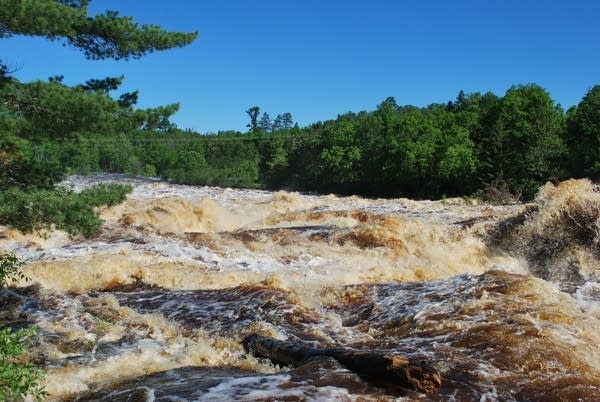Homes, mills feel rising waters in northern Minnesota

Go Deeper.
Create an account or log in to save stories.
Like this?
Thanks for liking this story! We have added it to a list of your favorite stories.
Torrential weekend rains over the Rainy River basin are causing record setting floods along Minnesota's border with Canada.
Six inches of rain in the past four days pushed Rainy Lake more than a foot into what the International Joint Commission, which regulates water flow on reservoirs along the border, considers flood stage.
A U.S. Geological Survey gauge at Manitou Falls shows the Rainy River rose nearly 10 feet since the beginning of the month — pushing this flood past a record set in 1950.
Those rising waters are currently threatening roughly a dozen homes and cabins on the lake shore and along the Rainy River, said Koochiching Sheriff's Department Capt. Jon Froemke. Many more home owners are building up sandbag walls as waters continue to rise.
Turn Up Your Support
MPR News helps you turn down the noise and build shared understanding. Turn up your support for this public resource and keep trusted journalism accessible to all.
Froemke ran the sandbagging nerve center Monday at City Beach in Rainier, Minnesota. Scores of volunteers rushed around him, Bobcats lifting heavily laden pallets, locals filling woven sacks by the shovel full and a crew of National Park Service workers operating a large sandbag machine.

Since Thursday, Froemke said hundreds of volunteers filled more than 85,000 sandbags and that should top 100,000 by Tuesday.
Some of those bags went to a massive effort to save the fire station in Loman, Minnesota, roughly 20 miles west of International Falls on Route 11. Water from the confluence of the Rainy and Black Rivers backed more than a foot over the road, closing Route 11, but the station is still dry thanks to 15,000 sandbags and dozens of muddy firefighters.
"It's been a long four days," Loman fire chief Adam Claybundy said, grinning.
So far the effort is keeping up with rising waters, although levels might not yet crest for days, said Froemke. "Water is coming here from 100 miles away in some cases," he said, "So we won't feel the full effect of the rain we had over the weekend for another five or six days."

The dam at International Falls is wide open to let as much water as possible through. Residents have stacked 70,000 sandbags so far to protect homes, with another 70,000 on the way.
East of International Falls, high water and strong winds on Rainy and Kabetogoma lakes have destroyed hundreds of docks. Volunteers have stacked sandbags around about 40 homes.
Rainy Lake rises slowly, which offers some hope for those worried about flooding. "Hopefully we can stay ahead and help these people," said Koochiching County Commissioner Brian McBride, though he added that strong north winds could prove problematic because they can push water over to the Minnesota side of the lake, causing levels to further rise.
Since late May, the water level has risen more than 22 inches on Rainy Lake, according to data from the International Rainy-Lake of the Woods Watershed Board.

Froemke said Rainy, Kabetogoma, and Namakan lakes could rise 2 feet more in the next six days.
Under such a threat, sandbagging continued at a feverish pace Monday, even as the sun shone and bright white clouds dotted the sky.
Earlier Monday, across the Canadian border, the powerhouse in Fort Frances, Ontario, took all of its generators off line because cooling pumps were under water.
The powerhouse at the Boise mill in International Falls is also underwater and the company may be forced to shut down its generators as well.

Even if it stops raining significantly, "we could probably see increases for a while, maybe a week or so, and then a long time for it to come back down until the system flushes out," said Lee Grim, who serves on the international watershed board's water levels committee.
"Sadly, it's the old Johnny Cash song: 5 feet high and rising," Grim said. "It's going to continue to go up."


